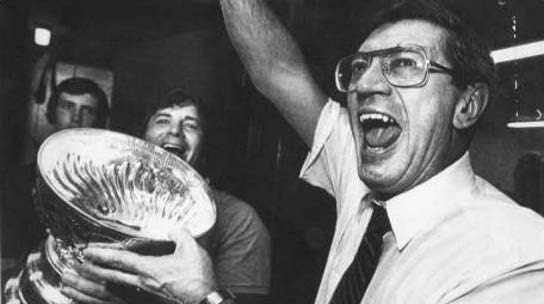Messages from Writers on Writing and Education
Former Beat Writer Reflects
Reflection with Newspaper Article Excerpt
Patrick Calabria
Reflection
Before entering the academic world, I was a sportswriter for Newsday. My first beat on a professional team was the New York Islanders. I covered the team from 1975 to 1984, including their four straight Stanley Cup championships. Al Arbour, their legendary coach, became a good and trusted friend of mine, and that relationship endured long after he retired (and I left journalism) and we stayed in touch. When Al passed a few years ago, Newsday reached out to me—by then I was Vice President for Institutional Advancement at Farmingdale State College—and asked me to write a remembrance of him. That’s the story I have included below.
In putting together my thoughts, my goal as a writer was to provide insight into the kind of person Al was. Readers of sports pages or TV viewers ordinarily do not get a sense of what a coach is outside of the rink, ballpark, or stadium. My objective was to explain what an extraordinary individual Al was, and why he was so beloved. To demonstrate this, I had to come up with examples that would resonate with the Newsday audience, whether or not they were even hockey fans. So I came up with a few you will see in the story—examples that I’d hoped would give readers a glimpse of the man behind the player’s bench.
To achieve this, I was conscious of avoiding overly technical sports language. And I wanted to write in simple, clear sentences that revealed my admiration and respect for Al, without anointing him as saintly or flawless. Clarity can’t be achieved with winding, aimless text. Every sentence has to have a point or a purpose. In effect, writing is like a chess match. One move leads to another which leads to another. The moves are not isolated. Rather, they are connected until arriving at a conclusion. And that conclusion—the ending—has to be unequivocal. It has to make a statement. It has to sum up everything you have said.
So this is what I wrote when I learned Al had passed.
Former Beat Writer Reflects on Islanders Legend Al Arbour
Courtesy of Newsday, August 29, 2015

Al Arbour wasn’t the coach that opponents and fans always saw—the genius with the frozen glare and the drab suits that ran the gamut from blue to dark blue. He was an innovator and a visionary, and no one ever handled the competing personalities of a star-studded team better. He was a great coach and an even better man.
He pioneered the use of videotape—don’t let anyone tell you differently—viewing the flickering images in a darkened room of his sprawling home in Cold Spring Harbor that his devoted wife, Claire, called “the dungeon.” It was there that he noticed between games of the 1976 quarterfinals against Buffalo that star center Gil Perreault regularly skated across the blue line with the puck and screeched to a stop at a spot between the faceoff circles.
Arbour directed his defensemen to converge on that space, forcing Perreault to surrender the puck. And Perreault scored only two goals while the Islanders swept the last four games to take the series, 4-2.
He and lifelong pal Scotty Bowman were among the first coaches to borrow the Russian concept of using five-man units, pairing defensemen with the same forwards, and there wasn’t a coach alive whom Arbour couldn’t outfox. He fooled his players, too, so they nicknamed him “Radar,” because he always seemed to know what they were thinking or doing.
And when the Islanders heatedly discussed whether to draft a young sniper, it was Arbour—who’d built his reputation as a player and coach on impenetrable defense—who told chief scout Jimmy Devellano, “Let’s go for the home run hitter.”
That’s how an overlooked right wing named Mike Bossy came to be an Islander.
He was before his time in so many other ways, some of them off the ice. When the Islanders were debating whether to allow a female reporter into the locker room in the prehistoric era of the 1980s, Arbour said he’d leave the decision up to the players, but urged them “not to do anything that would cost that young lady her job.”
And they relented.
He pretended to be hard-boiled, but the truth is he had a heart as soft as a jelly doughnut. He peeled the paint off the locker-room walls with his thunderous voice and a slam of his fist when the team needed a kick in the pants, but he cared about his players and loved most of them. When he was told that Jean Potvin, a pet defenseman, had been traded, he wept.
Returning after a stomach-roiling propeller flight from Boston one morning, he noticed that I’d caught a virus. But seeing the blood drained from my face, he told me to cancel the taxicab and gave me a lift home. I was around a long time, and I can’t think of another coach of his stature who would do that.
When I sat beside him on the deathly silent charter flight back from Edmonton after the dynasty was ended, his voice was choked to a whisper. I told him after four straight Stanley Cups that he had no reason to be sad. “I’m not sad for me,” he replied. “I’m sad for them,” and he pointed around the darkened cabin at his inconsolable players.
Once he retired, I called him at his home in Florida about once a year to check up on him, and after the last conversation we had, I knew the outlook wasn’t good. That time, I was the one who wept.
He had a combustible temper and he could stubbornly hold a grudge. He wasn’t perfect. But he was as close to a perfect coach and a perfect man as I’ve ever met.

